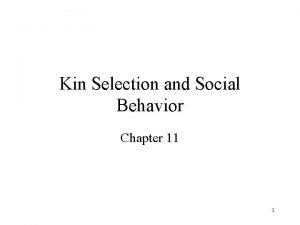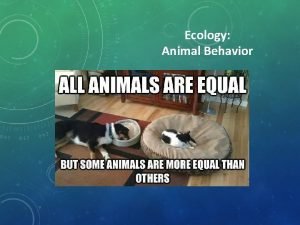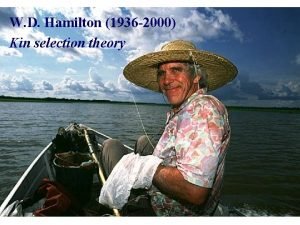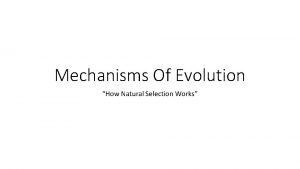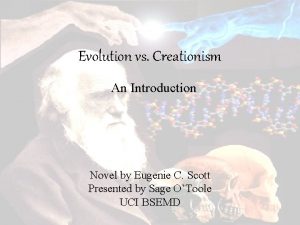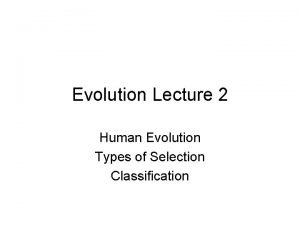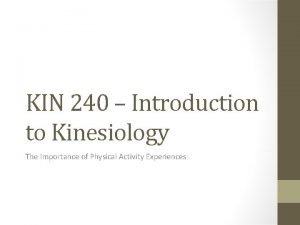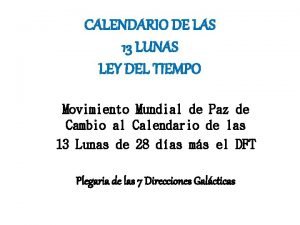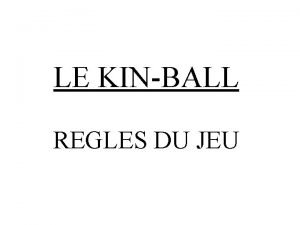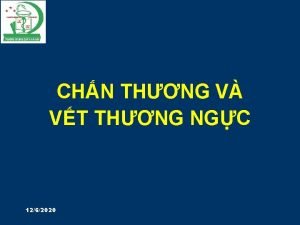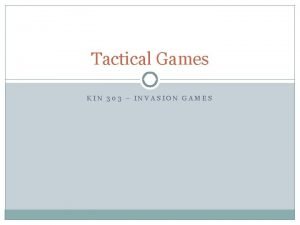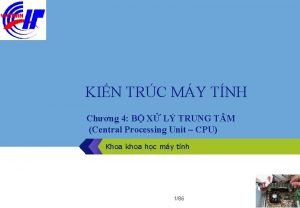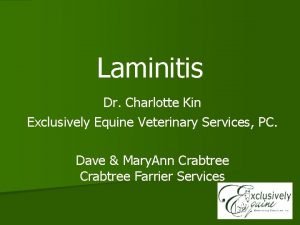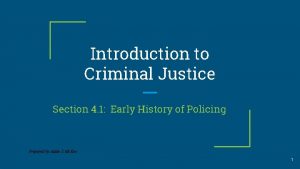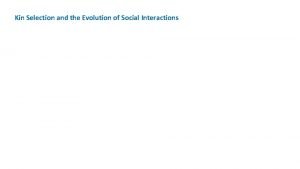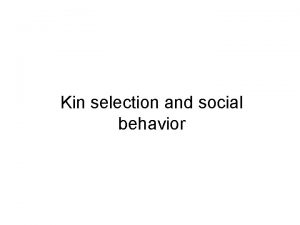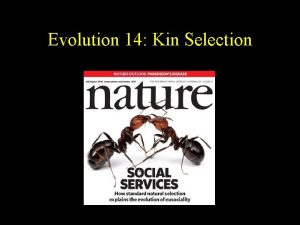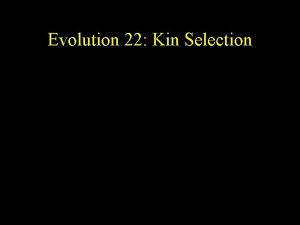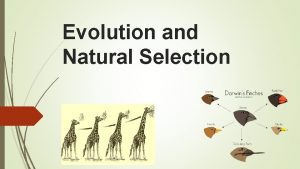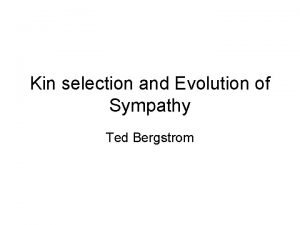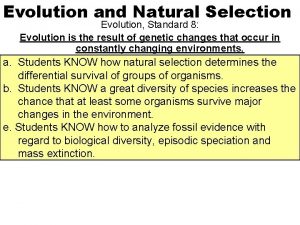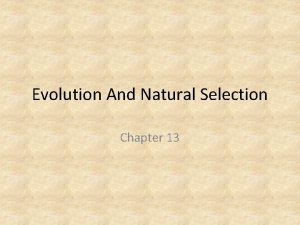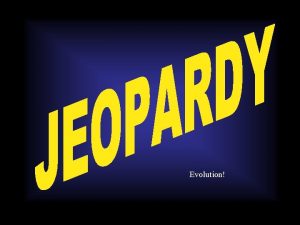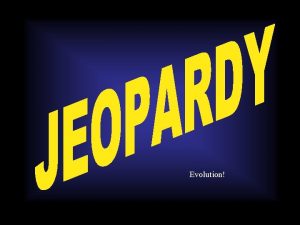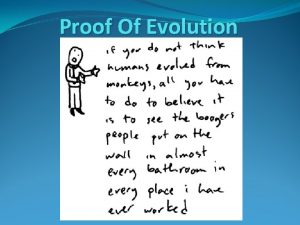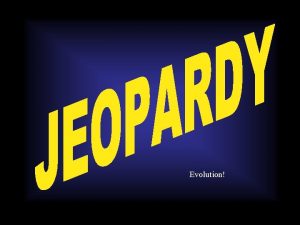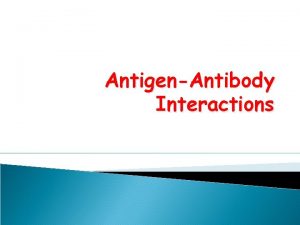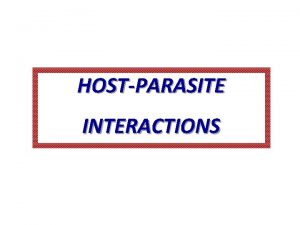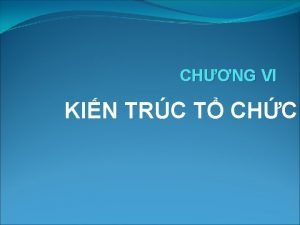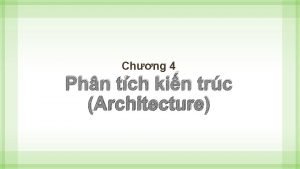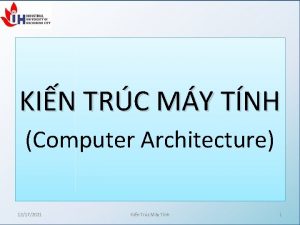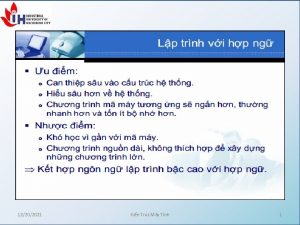Kin Selection and the Evolution of Social Interactions



































- Slides: 35

Kin Selection and the Evolution of Social Interactions

A. Darwin’s Dilemma …bees make me sad…

Social Behaviors, like all adaptations, must be evaluated on a cost/benefit analysis

B. Kin Selection 1. Haplodiploidy and Social Insects W. D. Hamilton – 1964 Coined the term “Kin Selection” and explained the selection for sterility – haplodiploidy in social insects …bees make me sad…

B. Kin Selection 2. Inclusive Fitness several relatives have more of YOUR genes, cumulatively, than YOU do! 1/2 ½ + ½ >1 1/2 1

B. Kin Selection 2. Inclusive Fitness 1/2 1/2 1

If I save myself… AAAAA !!!!! XX X X XX I save one “set” of my genes… 1/2 1/2 1 1

If I save my relatives… I save 1. 5 sets of my genes. If this has a genetic basis, selection will favor altruism among relatives. What a guy! …ow… 1/2 1/2 1 1/2

C. Altruism 1. Among relatives – a function of kin selection White-fronted bee-eaters

C. Altruism 1. Among relatives – a function of kin selection Tiger salamander

C. Altruism 2. Among non-relatives Direct Reciprocity/Reciprocal Altruism/Tit for Tat Nowak, M. A. 2006. Five rules for the evolution of cooperation. Science 314: 1560 -1563.

C. Altruism 2. Among non-relatives Indirect Reciprocity – “Reputation” “watcher” Nowak, M. A. 2006. Five rules for the evolution of cooperation. Science 314: 1560 -1563.

C. Altruism 2. Among non-relatives Network Reciprocity - - if everyone is connected to everyone else, then selection favors defectors. But if there are subgroups of interactors, then selectin can favor cooperation if b/c > k (mean connections). “The fewer friends I have (lower k), the stronger my fate is bound to theirs. ” Nowak, M. A. 2006. Five rules for the evolution of cooperation. Science 314: 1560 -1563.

C. Altruism 2. Among non-relatives Group Selection Nowak, M. A. 2006. Five rules for the evolution of cooperation. Science 314: 1560 -1563.

C. Altruism 2. Among non-relatives Group Selection Pseudomonas flourescens Colonies with high concentration of mat-builders (expensive proteins) float; if cheaters increase in number, colony sinks and dies. Nowak, M. A. 2006. Five rules for the evolution of cooperation. Science 314: 1560 -1563.

Problems with group selection (Pinker 2012): 1) Natural selection has three critical elements: - Units replicate with high fidelity - ‘Mutations’ create variation during replication - Resources are limiting - Replicators with mutations that increase replication rate in this environment will increase

Problems with group selection (Pinker 2012): 1) Natural selection has three critical elements: - Units replicate with high fidelity - ‘Mutations’ create variation during replication - Resources are limiting - Replicators with mutations that increase replication rate in this environment will increase 2) Applications of ‘Group Selection’ - warfare: risking life for success of nation. - morality: groups with virtue, honor, and duty to group win over selfish groups

Problems with group selection (Pinker 2012): 1) Natural selection has three critical elements: - Units replicate with high fidelity - ‘Mutations’ create variation during replication - Resources are limiting - Replicators with mutations that increase replication rate in this environment will increase 2) Applications of ‘Group Selection’ - warfare: risking life for success of nation. - morality: groups with virtue, honor, and duty to group win over selfish groups 3) Problems: - Groups don’t replicate – individuals do. And those who sacrifice don’t reproduce, so how does this strategy get selected for within the group (except for kin selection and network cooperation? ) - c/b ratio of participation in warfare and ‘moral choices’ are imposed by the state. - if participation in war is beneficial to individual, some might do it. - if costs of cheating are very high (prison), some might not do it. - Countries don’t ‘win’ wars through replication - Human behavior is best explained by kin and reciprocity, not sacrifice to group. Even in cases of sacrifice, it is to a subset of the group – the network of reciprocators – “Band of Brothers”. - Good groups might win; but it is not as a result of group selection.

Vogel, G. 2004. Evolution of the golden rule. Science 303: 1128 -1131. Game: Give one monkey a pebble. If it gives it back (cooperation), it gets a cucumber slice.

Vogel, G. 2004. Evolution of the golden rule. Science 303: 1128 -1131. GRAPE? … what the $%#@@!! Game: Give one monkey a pebble. If it gives it back (cooperation), it gets a cucumber slice. Repeat with a second monkey, in view of the first, but give the second monkey a grape (better reward).

Vogel, G. 2004. Evolution of the golden rule. Science 303: 1128 -1131. Game: KEEP your #$#@ CUCUMBER!! Give one monkey a pebble. If it gives it back (cooperation), it gets a cucumber. Repeat with a second monkey, in view of the first, but give the second monkey a grape (better reward). First monkey will no longer return the pebble for a cucumber. Fair trade. Capuchin monkeys refuse to cooperate when they see a comrade receive a better reward for the same task.

Chimps helping strangers - • 36 wild-born chimps (orphaned) – Uganda • Two novel experimenters struggle over stick, thrown in cage • Experimenter reaches for stick • Does chimp help and get the stick in 60 sec? http: //journals. plos. org/plosbiology/article? id=10. 1371/journal. pbio. 0050184#s 4

Chimps helping strangers - yes, as often as 18 month old children if the experimenter reaches for it.

Chimps helping strangers http: //www. livescience. com/animals/070625_chimp_altruism. html Still, humans at the sanctuary provide the chimpanzees food and shelter, so helping people out could simply be in their best interests.

Chimps helping strangers http: //www. livescience. com/animals/070625_chimp_altruism. html 9 unrelated chimps ‘trained’ to use a mechanism in a pre-test.

http: //www. plosbiology. org/article/info%3 Adoi%2 F 10. 1371%2 Fjournal. pbio. 0050184#pbio-0050184 -sv 003 • Both the target and the distracter door were held shut by chains. • subject (S) could release the chain of the target door. • In the experimental condition, food was placed in the target room (subject could help) by releasing the target chain. In the control condition, food was placed in the distracter room, so that the recipient would try to open the distracter door. In this situation, it was irrelevant (with respect to the recipient's attempt to open the distracter door) whether the subject released the target chain. The target measure in both conditions was whether the subject released the target chain. (from Warneken, PLOS 2007). • 3 acted as recipients and 6 as subjects – 10 trials for each pairing; 5 experimental and 5 controls (banana in ‘distractor’ room).

Mean percentage of trials with target behavior (releasing the target chain) by condition. Error bars represent SEM. Each subject was tested in both conditions in a within-subject comparison. (Warneken, PLOS 2007). Subjects pull bar for recipient to access food significantly more often than the control (p < 0. 025). Difference increased over trials.

D. Conflicts within Families

D. Conflicts within Families 2. Parent-Parent IGFII gene – stimulates growth On in males, stimulating the growth of their own offspring; off in females, as she bears the cost of growing embryos and all are hers.

D. Conflicts within Families 2. Parent-Parent IGFII inhibitor gene – slows growth Off in males, stimulating the growth of their own offspring; on in females, as she bears the cost of growing embryos and all are hers.

D. Conflicts within Families 2. Parent-Offspring Parent’s potential for future reproduction may favor them investing in survival rather than parental care.

D. Conflicts within Families 2. Parent - offspring Selection can favor parents that abort care of current offspring to improve survival and future reproductive success…

D. Conflicts within Families 2. Parent - offspring Selection can favor parents that abort care of current offspring to improve survival and future reproductive success…

D. Conflicts within Families 2. Sibling - sibling

D. Conflicts within Families 2. Sibling - sibling
 Hamilton's rule biology
Hamilton's rule biology Kin selection
Kin selection William hamilton kin selection
William hamilton kin selection Qualities behaviors and complexities
Qualities behaviors and complexities Natural selection
Natural selection Two way selection and multiway selection
Two way selection and multiway selection Two way selection and multiway selection in c
Two way selection and multiway selection in c Mass selection and pure line selection
Mass selection and pure line selection 3 types of natural selection
3 types of natural selection Mechanisms of evolution
Mechanisms of evolution Natural selection vs evolution
Natural selection vs evolution Evolution types
Evolution types Accounting information system chapter 1
Accounting information system chapter 1 Balancing selection vs stabilizing selection
Balancing selection vs stabilizing selection Artificial selection vs natural selection
Artificial selection vs natural selection K selected
K selected Natural selection vs artificial selection
Natural selection vs artificial selection Artificial selection vs natural selection
Artificial selection vs natural selection What is stabilizing selection
What is stabilizing selection Logistic model of population growth
Logistic model of population growth Natural selection vs artificial selection
Natural selection vs artificial selection D kin
D kin Kin 240
Kin 240 Tabla de tonos galacticos
Tabla de tonos galacticos Kin ball regle
Kin ball regle Kin 464
Kin 464 Chấn thương ngực kín slide
Chấn thương ngực kín slide Life orientation grade 7 term 2 exam papers
Life orientation grade 7 term 2 exam papers Kin tes
Kin tes Logo kin
Logo kin Charlotte kin
Charlotte kin Kin 257
Kin 257 Kin 240
Kin 240 Kin policing
Kin policing Tsui ka kin
Tsui ka kin Pinna acoustics
Pinna acoustics
